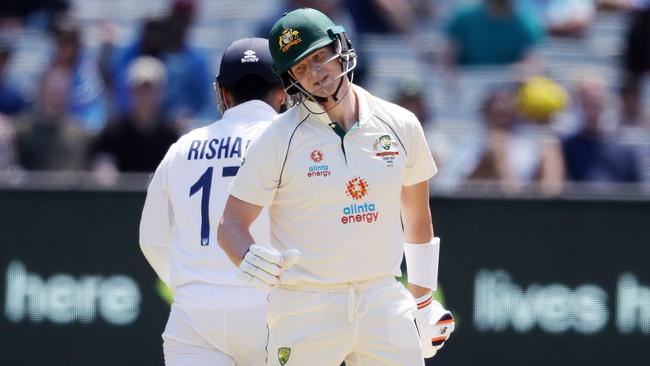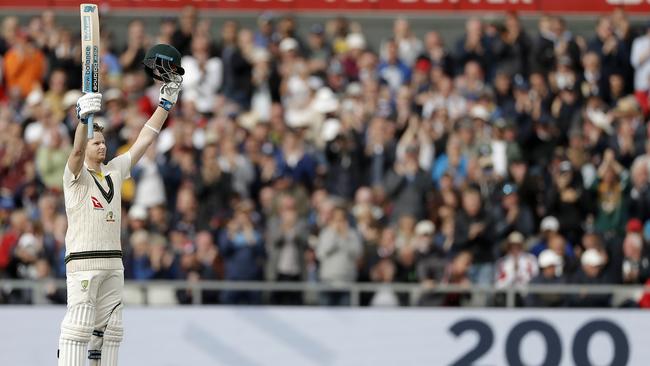Australia vs India cricket: Steve Smith’s mojo is still missing

From 2013 to 2019, Steve Smith’s Test record developed into a kind of Uluru of cricket: amazing from every angle, impossible to stop staring at. During his comeback series in last year’s Ashes, his average bulged to more than 65. When would its upward trajectory cease, we wondered? In fact, it already had.
This happens. Having passed through three-figures the first time, even Bradman’s average fluctuated, rising as high as 112, falling as low as 89.5, before settling at 99.94.
With a rather tremulous eight-ball duck at the MCG on Saturday, Smith brought his post-Ashes Test average to 28; his strike rate in that time of 34, too, compares to a career 55. In that period he has not added to his twenty-six Test hundreds; he has hit one six.
Last season in Australia, Smith loitered palely, troubled, at least on the face of it, by Neil Wagner’s bouncers.
To put that behind him, Smith announced at the top of this summer that he had ‘found my hands’ again, which he was ‘extremely excited about’, after ‘three-and-a-half or four months’ of misplacing them. As if to confirm the return of this peculiar fingerspitzengefühl, he tapped out consecutive 62-ball centuries in the one-day internationals against India in Sydney.
Test cricket, however, will always pose more questions, and Smith’s hands have tensed anew. He has been at the crease for an hour in the series for two slightly fretful singles.
The situation was set up for him here yesterday, on a ground where his average is triple figures. He arrived instead amid a cordon of close fielders so close they should almost have been wearing masks.
Smith’s seventh ball turned past the bat and keeper to leg; his eighth, almost identical, he followed as if transfixed, watching it all the way into Pujara’s hands at leg slip. Public health messages on the big screen had been reminding spectator to avoid touching face and mouth; as he watched the replay, Smith could not help cupping a disbelieving hand to his head.
Perhaps it is simply the turn of the wheel. Perhaps it is the recently dicky back and general lack of long-form cricket. Captains have had a long time to study his technique, his trigger movement, his scoring areas: the leg-side singles he seemed to accumulate at will appear to have dried up.

Perhaps it is his preparatory method, which accents volume, volume and volume. Smith must have hit at least a thousand balls coming into this Test, from teammates, net bowlers and coaches. It’s a good drill for mechanically grooving shots; arguably less good for refraining from shots. About this stroke there was something involuntary, almost automated.
Smith’s fall left Australia three for 38; on the basis of Adelaide, they might conceivably have declared at this point. Perhaps this even got to them a little. Half of Australia’s batsmen fell to shots they needn’t have played. Travis Head ended the day’s best partnership, 86 in 167 deliveries with Marnus Labuschagne, by nicking his pet back foot punch — a stroke he may fancy a little overmuch.
India’s locum skipper Ajinkya Rahane, meanwhile, was as positive as his pre-match take on the First Test (‘We had two good days, just one bad…’). Lending a green shade to the pitch’s traditional biscuit brown, eleven millimetres of grass provided purchase for the spinner as well as the seamer, and Rahane pressed accordingly. Ashwin bowled the tenth over, Ravi Jadeja the nineteenth; a short backward square leg was posted for Matthew Wade, a short cover for Marnus Labuschagne, two short mid-wickets for Cameron Green.
Wretched last week, India’s fielding also improved. Rahane’s day in the field started when he let a ball run between his feet at gully, but continued with two smart saves there, diving to his left. Shubman Gill almost spoiled Ravi Jadeja’s catch from Matthew Wade’s top edge, but made Mohammad Siraj’s day by snaffling Labuschagne at leg gully. Rishabh Pant allowed ten byes in Australia’s first 79 runs but later saved four more with a jack-in-the-box leap to arrest a Bumrah bouncer.
With a sharp throw, Umesh Yadav should by rights have run Australia’s captain out when Tim Paine was 6 — Pant had clearly disarranged the bails with the bat having barely transited a fat crease line. If Paine stumped Moeen Ali at Brisbane in 2017, then he was comfortably short of his ground here. It did not prove costly. Such ‘missing’ frames are bound to in due course.
When they took the field, Australia’s slips stood close — a hint that they judged the pitch slow, the carry poor. Starc was still too swift for Mayank Agarwal, who got his bat trapped behind his pad. But having denied himself a split-second of reaction time, Labuschagne shelled Gill at third slip. Had the catch been taken, India’s last fifteen wickets in the series would have fallen for 51 in 173 deliveries. The tourists’ hope will now be that what has gone down is about to come up.







What goes up must come down. Few forces are so powerful in cricket statistics as reversion to the mean. Which even the world’s top ranked Test batsman is now feeling the effects of.